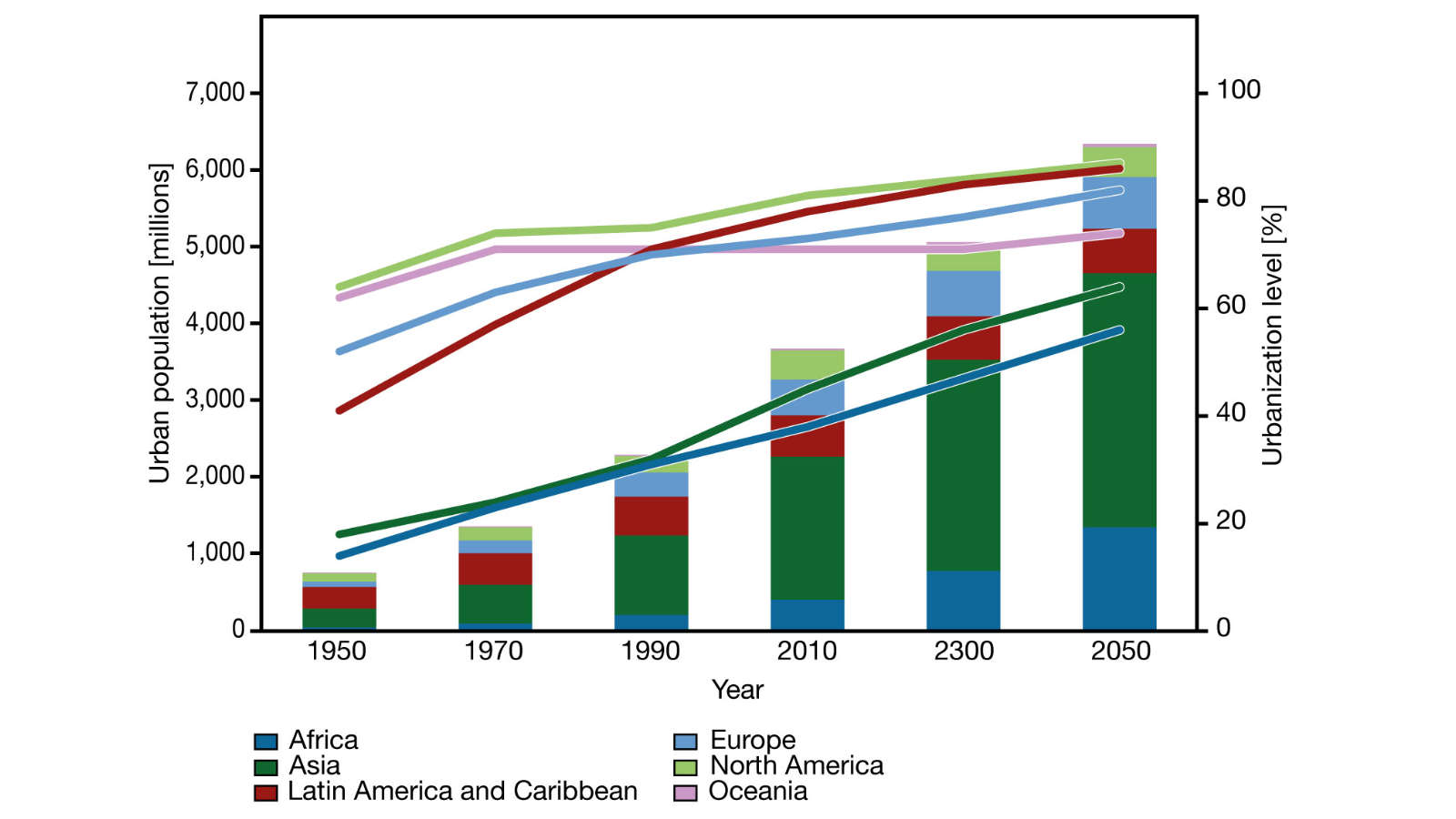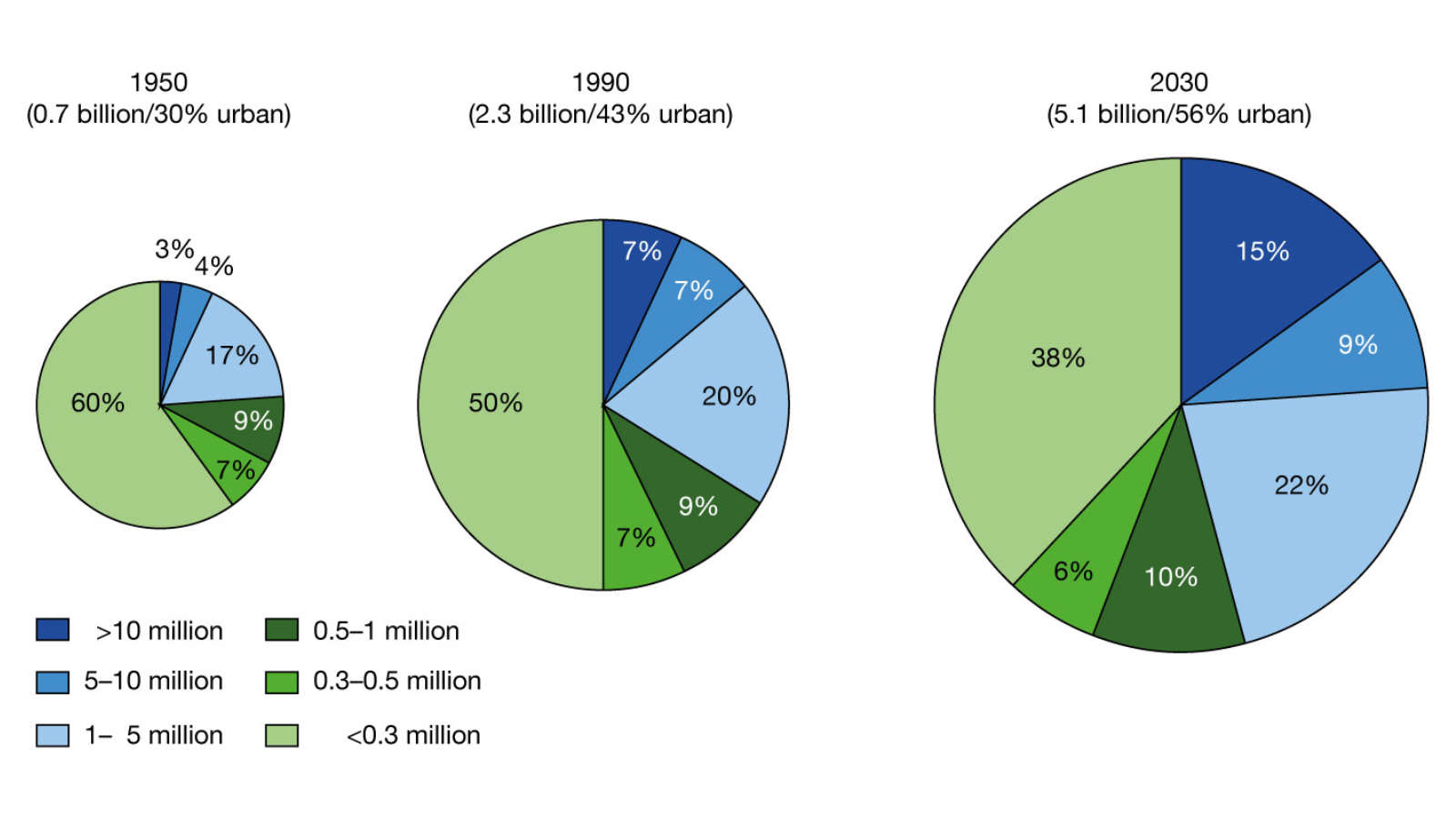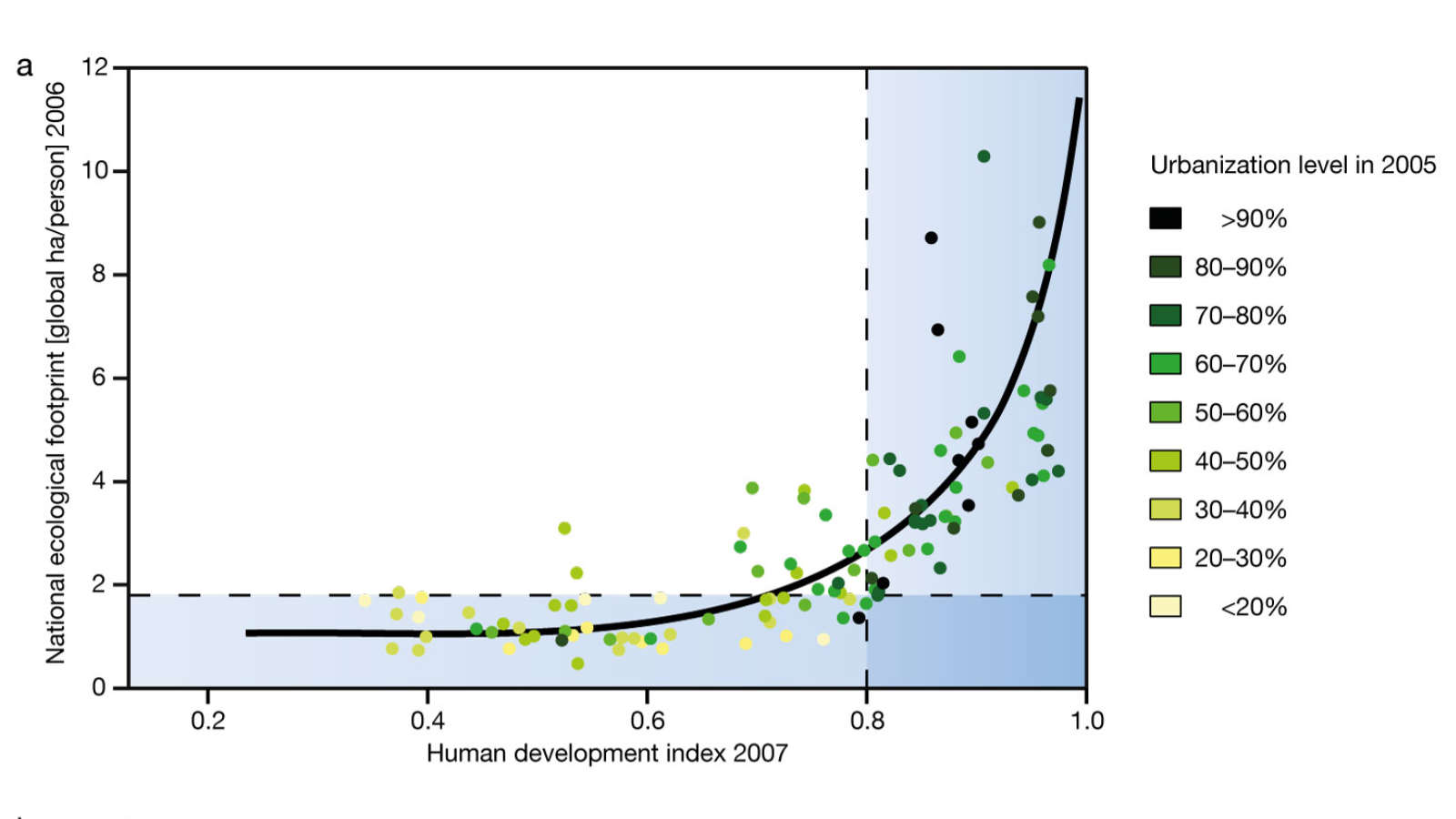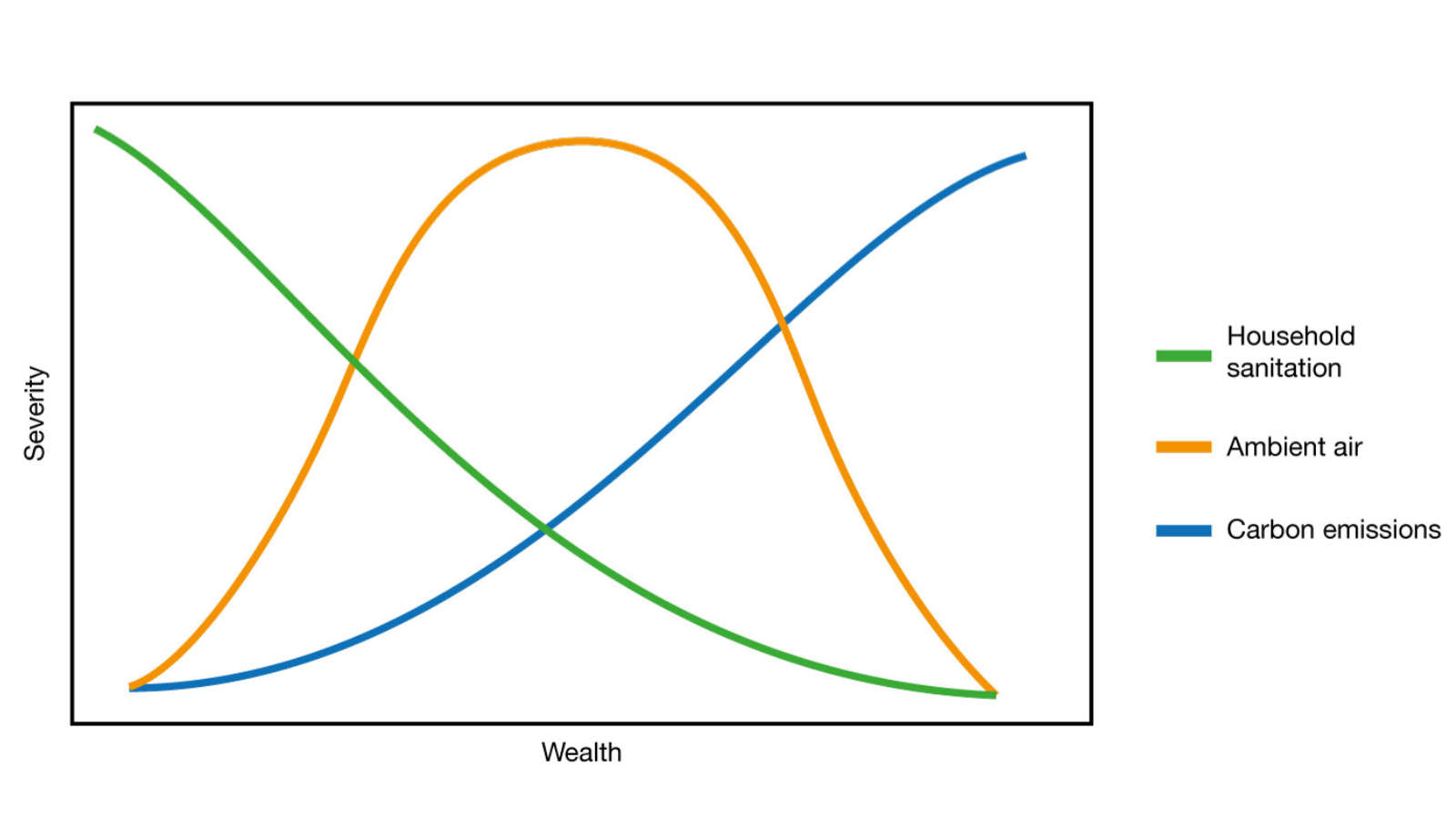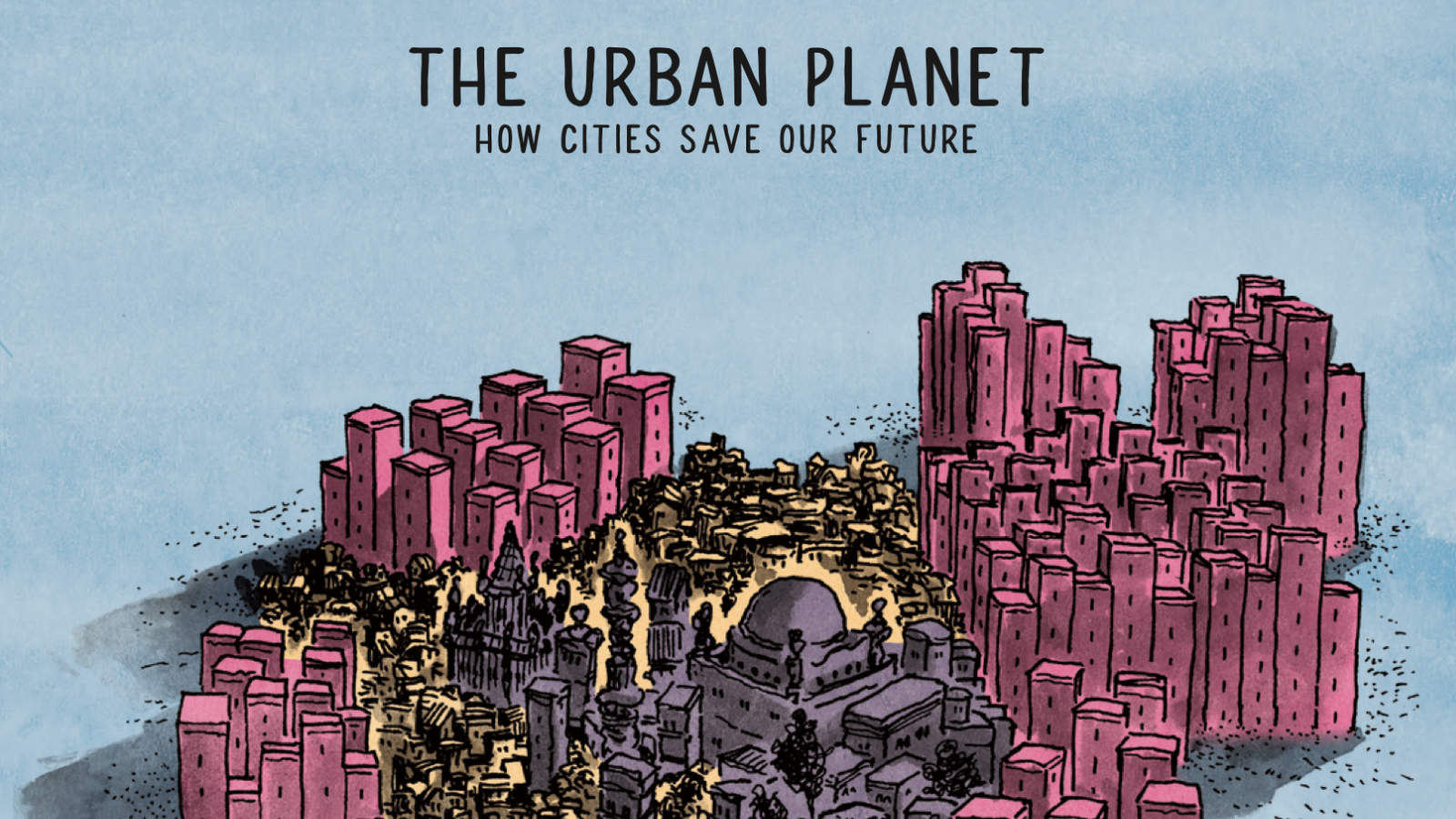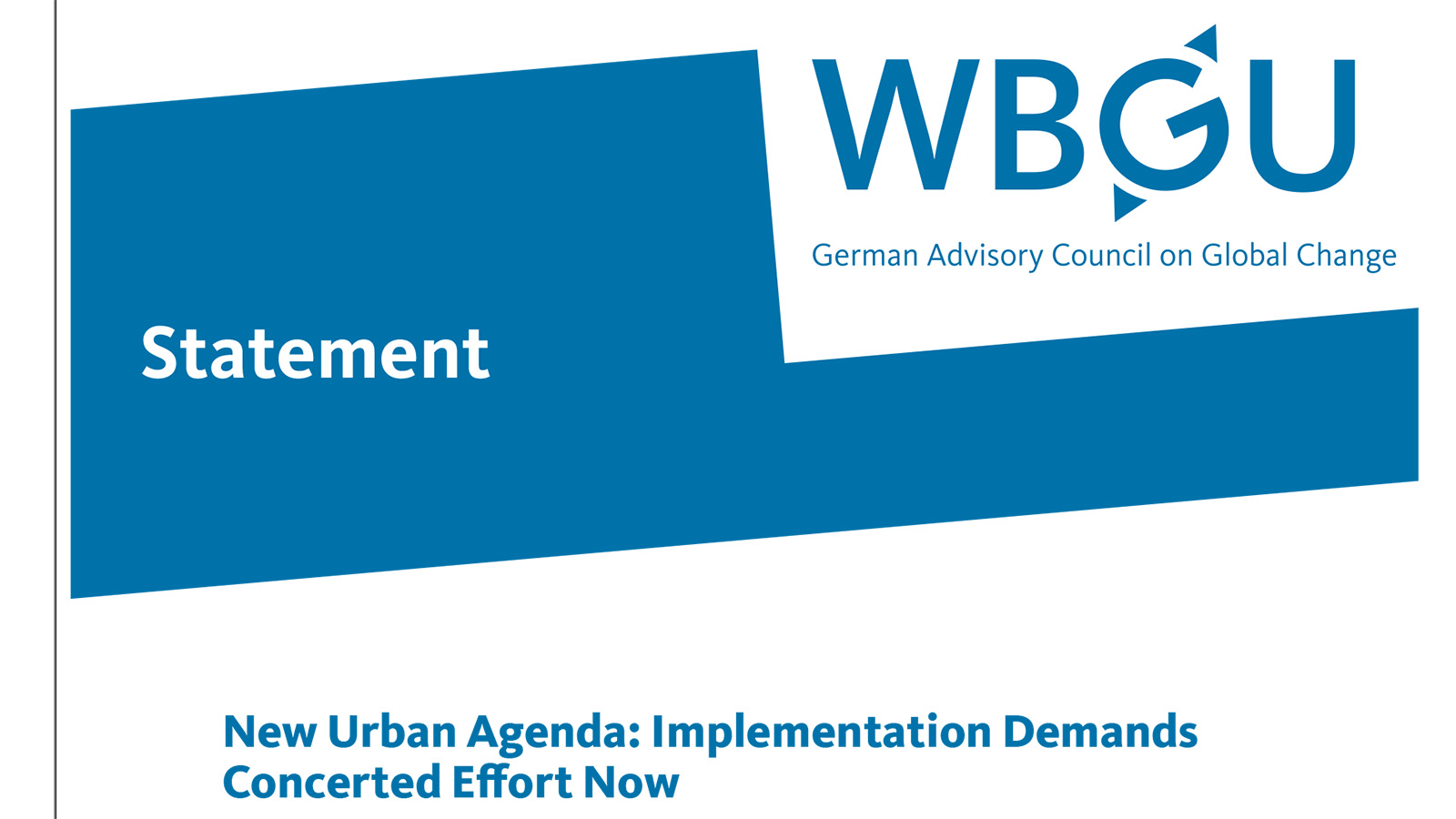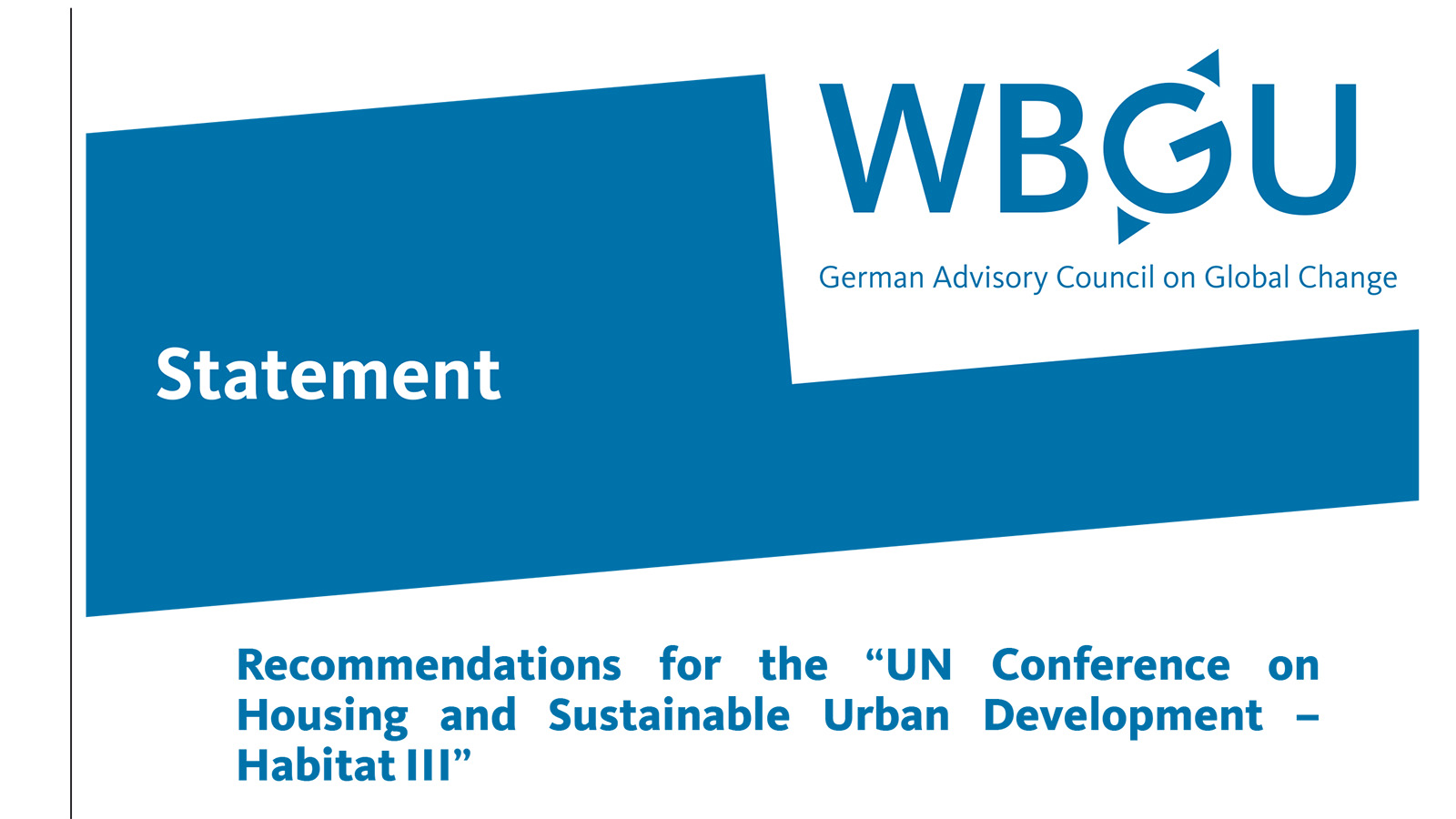Humanity on the move: Unlocking the transformative power of cities
The momentum of urbanization and its impacts are so massive that we must face up to this trend.
Overview
More about this topic
What kind of homes should people live in? Where can they settle? How close may their neighbours encroach on them? These questions are as old as our civilization, but in the 21st century they are being asked in a new way. Because this century is characterized by a contradiction dynamic that eclipses much of our previous experience of social change: rapidly growing populations in many developing countries versus shrinking populations in some industrialized countries; the enrichment of tiny elites versus the ongoing economic marginalization of the majority; guarded luxury real estate surrounded by squalid, poor neighbourhoods in many megacities; improved access to basic supplies and services for billions of Earth dwellers, while at the same time their long-term life-support systems are being destroyed by resource looting, climate change and environmental pollution. The present report outlines the special challenges and opportunities faced in this century by cities from the perspective of the necessary transformation towards sustainability. One characteristic feature of the debate on the search for solutions is the enormous diversity of instruments and solution pathways. Consequently, there can be no blueprint for sustainable urban development.

The century of the cities
The 21st century will be the century of the cities. Urban areas are becoming the central organizational form for almost all human societies. The global urban population could increase from just under 4 billion today to 6.5 billion people by 2050 – and urban infrastructures will grow with it. About two-thirds of humanity will then have their homes in cities. The force of the urbanization surge will primarily affect developing countries and emerging economies in Asia and Africa. Almost 90% of urban-population growth up to 2050 is expected on these two continents. Nearly three quarters of the global urban population will then be living there.
The success or failure of the transformation towards sustainability will be decided in the cities
The progress of the Great Transformation will depend substantially on the decisions that will be taken in cities over the next few years and decades. There is a need for a paradigm shift away from incremental approaches that are essentially driven by short-term requirements, towards transformative changes with a strategic, long-term view of humanity’s natural life-support systems and the creation of a form of urbanity that sustainably promotes human quality of life. In this context, it is not so important to look to the future from today’s perspective, which usually makes the path already being followed look inevitable; rather, one should look back to the present from a desirable future: what paths should be followed and what dead-ends should be avoided today to make this sustainable future possible?
A normative compass for urban development
The WBGU has developed a ‘normative compass’ to help shaping the massive changes in the ‘century of cities’ in a people-oriented way. This compass comprises three dimensions:
- First, sustaining natural life-support systems by complying with planetary guard rails and protecting the local environment.
- Second, ensuring substantive, political and economic inclusion for the city dwellers.
- Third, the WBGU draws attention to the socio-cultural and spatial diversity of cities and urban societies, as well as the resulting plurality of urban transformation pathways: every city must seek ‘its own way’ to a sustainable future. This Eigenart (a German word meaning ‘character’) is not only hugely important for creating urban quality of life and identity, it is also an indispensable resource in the sense of developing each city’s specific potential for creativity and innovation. With the dimension of Eigenart, the WBGU is introducing a new category into the sustainability discussion.

Demands on the urban transformation
In the WBGU’s view, an urban transformation towards sustainability that is oriented towards quality of life and human prosperity must be based on the following demands.
Demands on infrastructure
In the past, infrastructure development has failed to keep pace with the breakneck urbanization process. More than 850 million city residents live in inadequate housing. In cities around the world, approx. 750 million people have no access to adequate sanitation, and 150 million no access to clean drinking water. In the low-income countries, about a third of city residents have no access to electricity and around three quarters lack access to modern energy sources for cooking. Providing these people with access to an adequate basic infrastructure will, in itself, be a major challenge. In addition, new homes and urban infrastructure will have to be built at great speed for approx. 2.5 billion new city dwellers by the middle of the century. The great challenge will be to make the right decisions now to ensure that this massive surge of urbanization follows the principles of sustainability.
Demands on urban quality of life
The process of the urban transformation is not only about urban design and infrastructure development within the planetary guard rails, but also about how adequate housing can be secured for over 850 million people who are currently living in slums and, furthermore, how urban quality of life can be improved for people. In addition to the challenges of creating jobs in cities, there are two fundamental questions. First: How must cities be designed for people to feel at ease and be able to develop their potential? Second: How can people influence dynamic urbanization processes or participate in them, when many urban areas are passing through profound changes or are being built completely from scratch in a short period of time? People-oriented cities develop primarily if citizens can participate in their design. On the one hand, the influence of large-scale real-estate investors in the metropolises of many industrialized countries and emerging economies is so dominant that a people-oriented, sustainable urban development and a good quality of life are no longer given sufficient consideration by local governments and other decision makers responsible. On the other hand, at the other end of the spectrum of development, in 2012 there were more than 850 million people who had to fend for themselves. They live in informal, often degrading settlements, and their number could more than double by 2050.
Demands on environmental protection
Cities should be environmentally friendly and offer people a healthy living space. This makes environmental protection in the cities one of the most important
requirements with regard to quality of life and the prosperity of the urban population – and therefore also for the urban transformation.
- Indoor and outdoor air pollution is the biggest environmental health risk: it is blamed for approx. 7 million premature deaths per year worldwide, most of them in cities. A total of about 600,000 premature deaths were caused by air pollution in Europe in 2010.
- Very many cities are already affected by water scarcity and water pollution: around half of all cities with more than 100,000 inhabitants worldwide are located in water-scarce basins. Water scarcity can be expected to get much worse as a result of climate change and the growth of these cities. Water pollution is a typical problem of urban agglomerations, especially in developing countries and emerging economies, where water resources in urban areas are contaminated by untreated sewage.
- Waste disposal is predominantly a problem of cities. Compared to other country groups, the cities in industrialized countries generate the most waste per capita, but the growth rates are declining. However, the quantities are increasing rapidly in developing countries and above all emerging economies. The quantities of waste could double worldwide by 2025. Many urban areas have no organized waste collection and disposal, which has a seriously negative effect on public health. About 70% of municipal waste, some of which is hazardous, ends up on landfill sites, which often contaminate surface water, ground water or soils and emit greenhouse gases.
Urban areas also play a key role when it comes to the mitigation of climate change, because they are responsible for about 70% of global energy use and global, energy-related CO₂ emissions. At the same time, people in cities are affected by climate change.

Elements of a social contract for the urban transformation
The Great Transformation towards a sustainable society requires a cross-generational orientation framework to ensure harmonious coexistence among nearly 9 billion people. The WBGU speaks in this context of a ‘new global social contract for a low-carbon and sustainable global economic system’. In such an imagined agreement, individuals and civil-society groups, governments and the international community, businesses and academia pledge to jointly take on responsibility for the transition to a sustainable economic and social order. Against this background it is possible to define the idea of a global social contract more precisely, and to formulate it in detail as a ‘social contract for the urban transformation’. The social contract itself would be virtual in the sense of a societal agreement on the urban transformation. However, it should be mirrored worldwide and at different levels of governance in the form of fully formulated charters.
The three key elements of such a contract are
- a polycentric responsibility architecture,
- transformative action fields in cities,
- consideration of the WBGU’s normative compass.
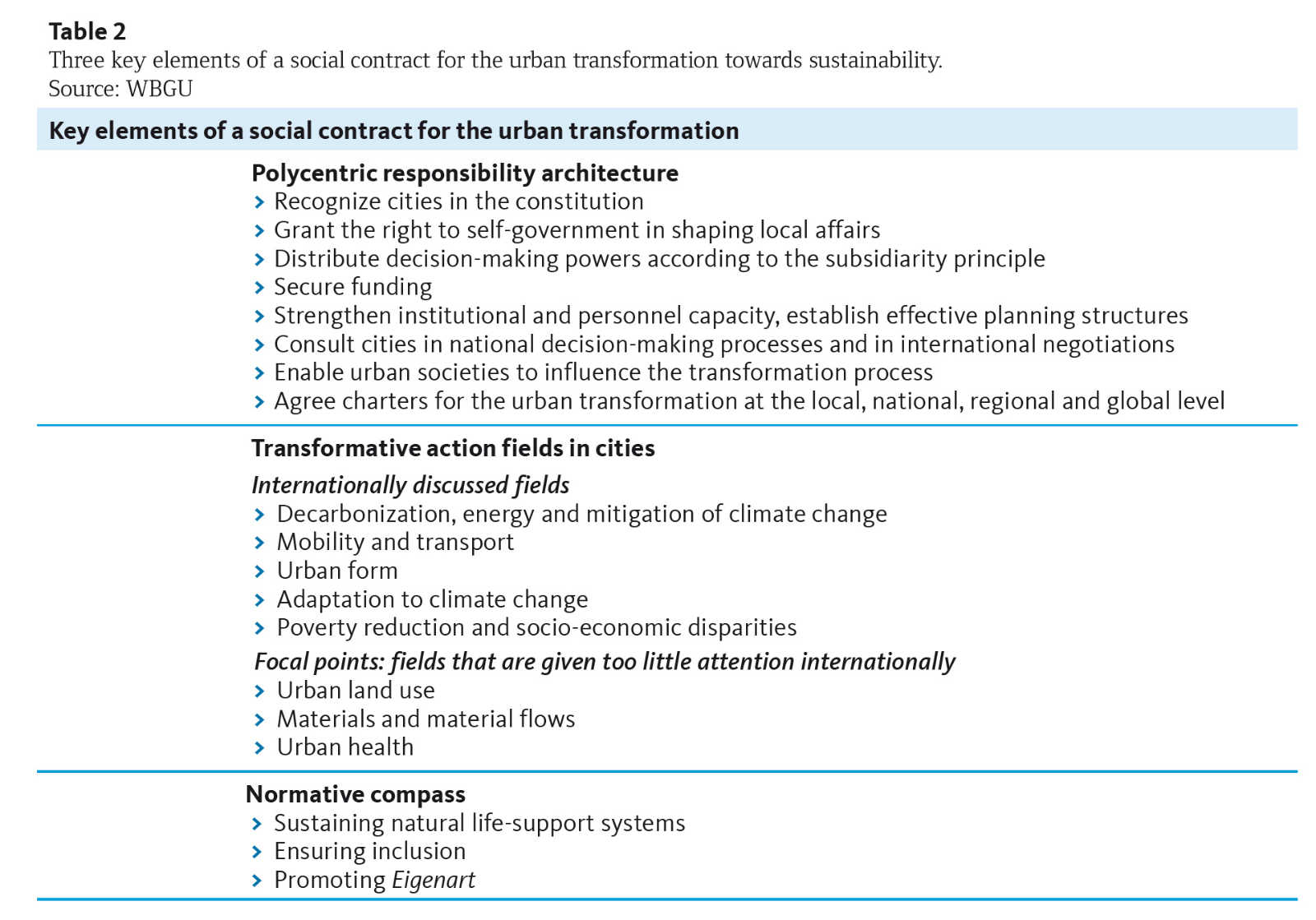

Core recommendations for transformative action fields
Transformative action fields are areas of urban development where the WBGU sees the greatest potential leverage effects for a successful urban transformation towards sustainability.
- Decarbonization, energy and mitigation of climate change – improve urban decision-making skills and strive for zero emissions: To achieve the urban transformation towards climate compatibility, direct CO₂ emissions in cities must be cut to zero and the demand for energy contained in order to make the global energy transformation towards CO₂-emissions- free energy systems possible.
- Mobility and transport – overcome the dominance of motorized private traffic: The objective should be accessible cities where certain locations (workplace, homes, etc.) are close together – pedestrian-friendly cities with safe cycle routes and affordable, low-carbon and good-quality public transport options accessible to all social groups.
- Link urban form to sustainability and adaptability: Low-carbon urban and city-district planning and development need locally adapted urban planning strategies that observe not only the respective geographical and cultural context, but also technical possibilities of implementation and maintenance.
- Adapt urban development to climate change: In order to reduce the risks of climate change for urban societies, strategies should be developed to protect the population (awareness raising, disaster preparedness), to prioritize infrastructure investments, and to integrate the mitigation of climate change and climate adaptation into long-term planning.
- Reduce poverty and socio-economic disparities in cities: In particular, local governments should make sure that urban poverty groups receive access to basic infrastructure and services. Conventional urbanization has mainly directed financial, personnel and creative resources into the development of residential areas for the upper 1-20% of the world’s population. New priorities need to be set here if a situation is to be prevented in which 3 billion people will be living in unacceptable, inhospitable, informal city districts in 2050.
- Ensure that land use is oriented towards the common good: In order to avoid negative path dependencies, transformative land-use management should concentrate on key principles wherever possible. These principles include the reduction of land degradation, a low-carbon, environmentally acceptable and socially compatible densification, orientation towards the common good, and a policy of flexibility and adaptability in land use. To make this possible, cities need adequate land tenure systems.
- Promote the sustainable stewardship of materials and material flows: Cities are hubs in the global flows of materials and resources. The growth of these flows involves a number of undesirable side effects. These include the destruction of natural landscapes, the release of toxic substances, and greenhouse-gas emissions. Furthermore, important resources could become scarce in a few decades if their extraction continues unabated. The transition in this century to a sustainable circular economy that is as complete as possible is therefore a key element of the Great Transformation towards sustainability.
- Strengthen resources and potential for healthy living in cities: Depending, for example, on their location, size and level of development, cities harbour specific possibilities and risks in the field of health for the urban population. The WBGU identifies the following key challenges: the increase in non-communicable diseases and the spread of unhealthy lifestyles and habits, the increasing risk of urban epidemics and new infectious diseases, and health disparities in cities. In view of ongoing global urbanization, the promotion of urban health is essential, since this is both a goal and a resource for the urban transformation towards sustainability.

Example cities
Mumbai: transformation of a colonial metropolis into a globally networked megacity
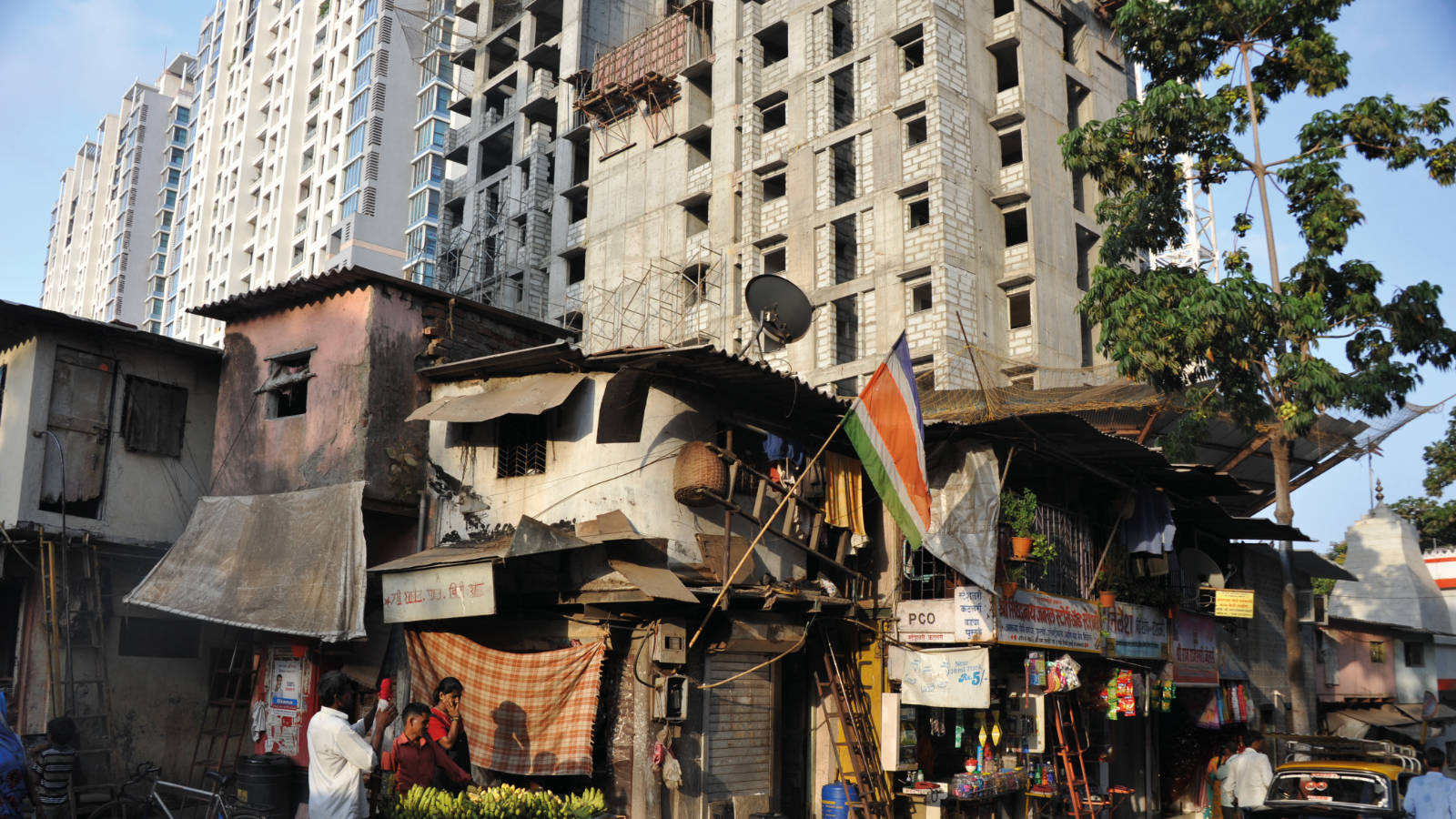
In view of its need to catch up in its urban development and expectations of its future growth, the main transformation challenges faced by Mumbai lie in the provision of adequate housing and basic services, and in reducing socio-economic disparities. Up to now, the population’s environmental footprint has been small by global comparison; nevertheless, the city should give a higher priority in urban planning to reducing resource use and emissions.
Cairo: metropolis between an authoritarian state and weak governance
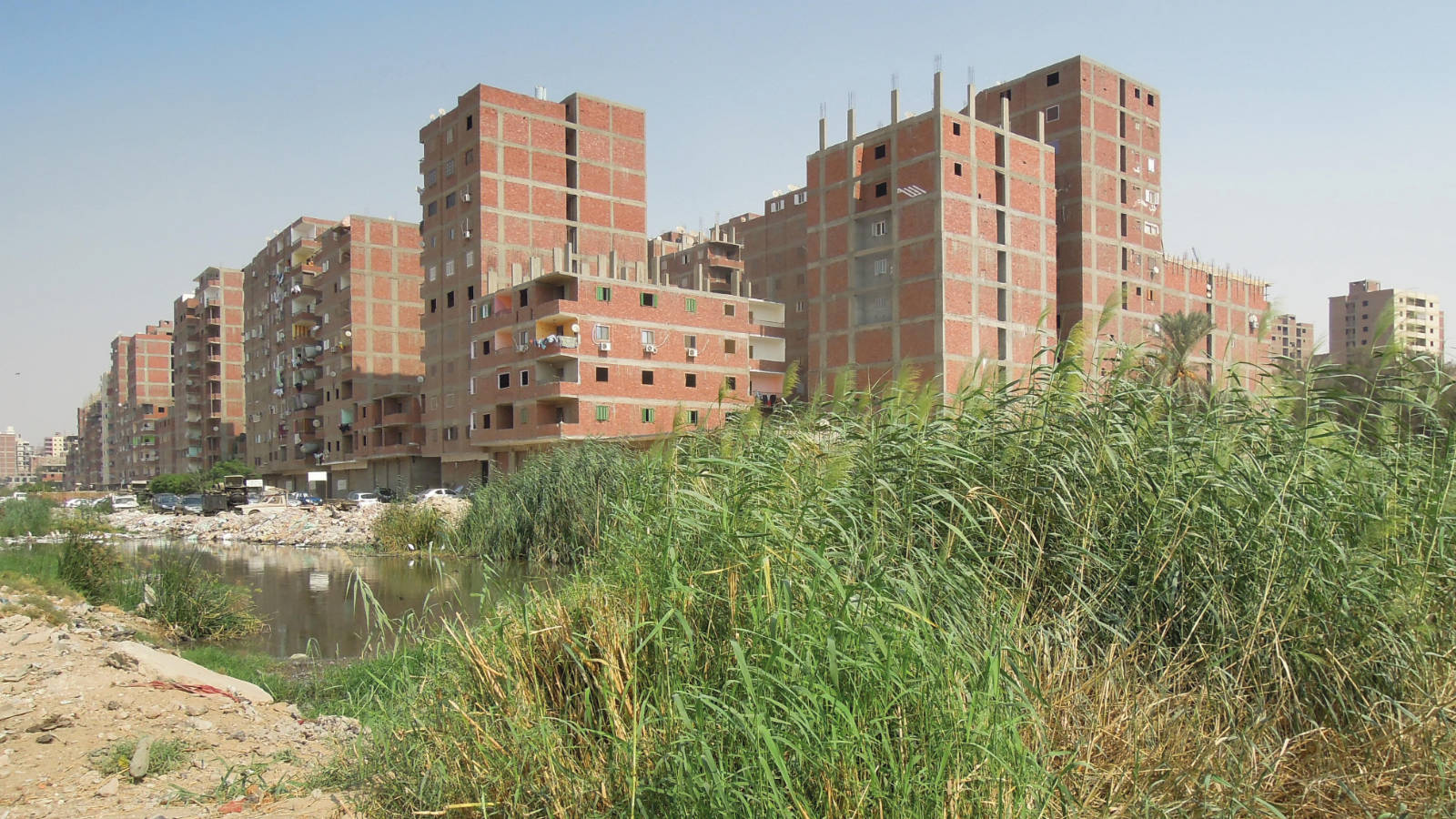
Greater Cairo has changed dramatically. The modestly sized city of the 1950s has developed into a metropolitan region characterized by a dualism of informal/unplanned settlements and newly planned desert cities. In the meantime, however, the first signs of a changed, integrated understanding of urbanism have begun to emerge. At present, the Egyptian government grants few political freedoms, and the Cairo local government is regarded as inefficient and corrupt. Only if the inclusion of the population can be greatly scaled up, and Existing rudiments of progressive urban-development strategies are further developed, can the transformation towards sustainability also succeed in Cairo.
Copenhagen: a people-oriented pioneer of sustainable urban planning

Apart from its globally renowned local and global initiatives on environmental sustainability, Copenhagen is also characterized by its people-oriented urban planning and design. Political inclusion and diversity are actively promoted by the local government. At the same time, this example shows that, there is still a long way to go to succeed in the Great Transformation towards sustainability.
Guangzhou: opening-up policy, globalization and migration- driven mega-urbanization in the ‘factory of the world’
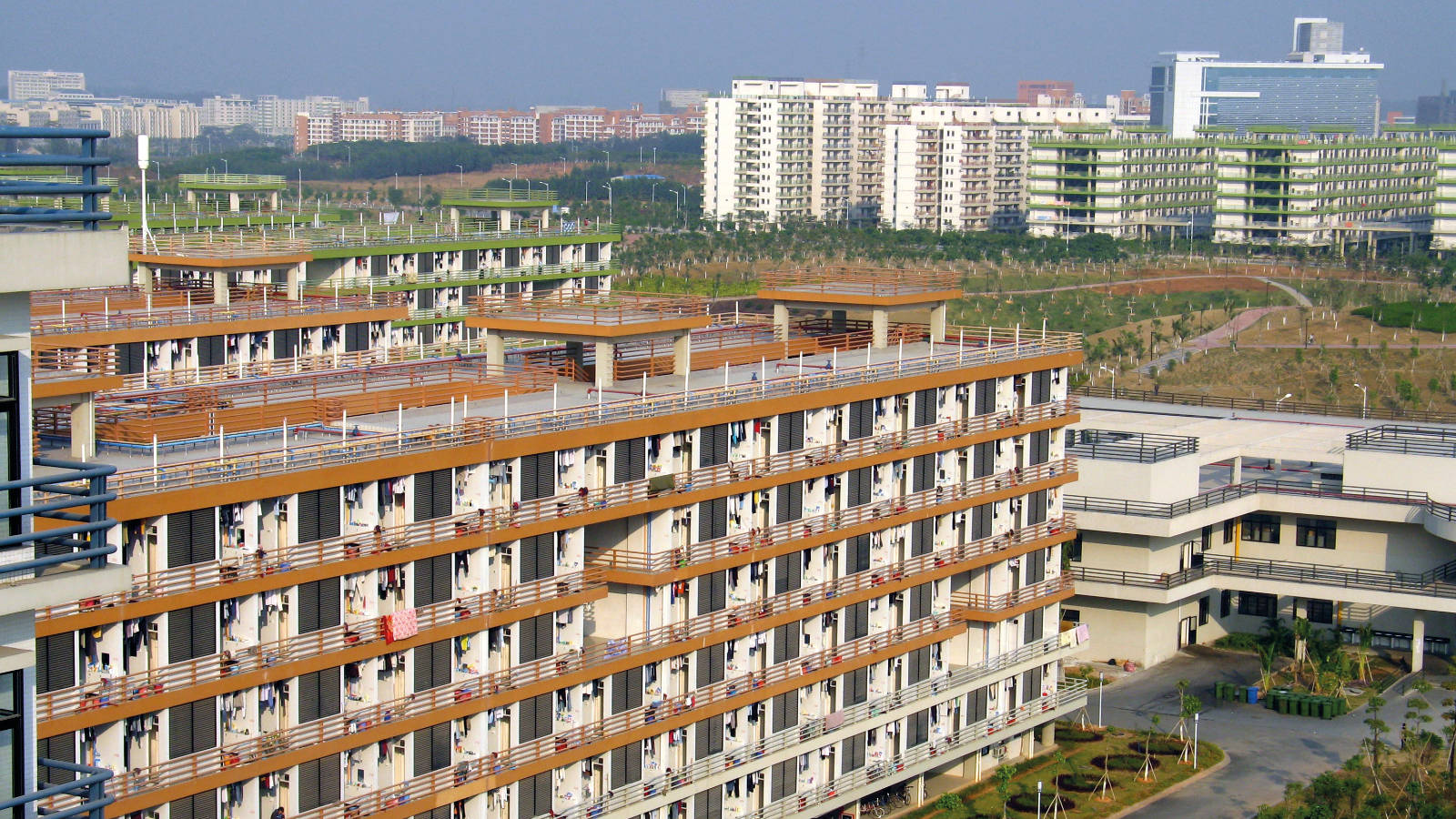
Guangzhou in China’s Pearl River Delta, the ‘factory of the world’, stands for numerous Chinese megacities that have experienced a profound upheaval in the space of three
decades. In the course of the politically induced policy of opening up to a market-oriented economy, they have been strategically and specifically redesigned into global focal points of foreign direct investment. Global centres of industry and services, high-density megacities and centres of internal migration have developed out of core regions of intensive agriculture.
São Paulo: the fragmented metropolis

In terms of its socio-economic and spatial development dynamics, its socio-spatial structures and urbane living conditions, São Paulo is a deeply fragmented metropolitan region with marked socio-spatial segregation tendencies. Yet São Paulo has both the planning capacity and (albeit certainly insufficient) financial capacity to tackle these problems and initiate independent developments in the direction of the transformation process.
More on the Subject
The Urban Planet
Research for the transformation of the cities towards sustainability
New Urban Agenda: Implementation Demands Concerted Effort Now
Recommendations for the “UN Conference on Housing and Sustainable Urban Development – Habitat III”
Habitat III has ended: Conference comes up short
Make urbanization an issue of international politics
Humanity on the move: Unlocking the transformative power of cities
Voices to this Report
Humanity on the move: Unlocking the transformative power of cities, is a notable breath of fresh air at a time when shallow platitudes seem the order of the day. It is bold, meticulously crafted through argument (as opposed to assertion) and evidence, and rooted in a highly original conceptual framework that is both global in scope and differentiated. The report asserts the centrality of cultural and institutional change and does not shy away from being specific and programmatic at a moment when it seems that political discourses are increasingly disconnected from our highly fractious, unsustainable, violent and intolerant times. I recommend it as compulsory reading in the strongest possible terms.
Professor Edgar Pieterse -
Director – African Centre for Cities (University of Cape Town) & Chairperson of the Cities Alliance Think Tank.
PDF and eBook Downloads
Deutsch
- Download: Vollversion hochaufgelöst (PDF 20,4 MB)
- Download: Vollversion (PDF 12,4 MB)
- Download: Kurzfassung (PDF 4 MB)
- Download: eBook (epub 2 MB)
English
- Download: Full Version (PDF 12,4 MB)
- Download: Full Version (high resolution) (PDF 17,1 MB)
- Download: Summary (PDF 4 MB)
- Download: eBook (epub 2 MB)
Español
- Download: Resumen (PDF 0,6 MB)
中国
- Download: Summary (PDF 32,4 MB)
Commissioned Expert's Studies
External expert studies are comissoned by WBGU, the responsibility for the content rests with the author.
- Download: Prof. Dr. Christoph Bieber und Peter Bihr – Digitalisierung und die Smart City. Ressource und Barriere transformativer Urbanisierung (PDF 772 KB)
- Download: Prof. Dr. Martin Coy und Dr. Tobias Töpfer – São Paulo: Aktuelle Entwicklungstrends und Möglichkeiten der Transformation zur Nachhaltigkeit (PDF 1,1 MB)
- Download: PD Dr. Daniel Schiller – Informalität in urbanen Ökonomien (PDF 585 KB)
- Download: Prof. Dr. habil. Guido Spars und Dr. Roland Busch – Auswirkungen der Internationalisierung der Immobilienwirtschaft auf Wohnungsmärkte und Stadtentwicklung weltweit (PDF 2 MB)
- Download: Peter Taylor, FBA, AcSS – The Role of Cities in the Process of Economic Globalization (PDF 730 KB)


